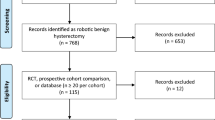Abstract
We aimed to compare perioperative outcomes of robotic-assisted hysterectomy versus vaginal hysterectomy in patients with benign gynecologic conditions, using a retrospective chart review of 240 consecutive benign hysterectomies from May 2008 to April of 2010 performed by a single surgical team at the Eisenhower Medical Center. The analysis included an equal number of cases in each group: 120 robotic-assisted total laparoscopic hysterectomies and 120 total vaginal hysterectomies. Consecutive cases met the inclusion criteria of benign disease. There were no statistically significant differences related to age, body mass index, history of prior abdominal surgery, or uterine weight. Operative times in the robotic group were significantly longer by an average of 59 min (p < 0.001). Patients with robotic-assisted hysterectomy had clinically equivalent estimated blood loss (55.5 ml vs. 84.7 ml, p < 0.001) and the intraoperative complication rates were 1.7% vaginal versus 0% robotic (p = 0.156). There was one conversion in the vaginal group due to pelvic adhesions and no conversions in the robotic group. Length of hospital stay was 1 day for both groups. The perioperative complication rates were equivalent between groups (6.7 vs. 11.7%, p = 0.180), but there were more major complications in the vaginal group (0 vs. 3.3%, p = 0.044). We conclude that, in a comparable group of patients, robotic-assisted hysterectomy takes longer to complete but results in fewer major complications.

Similar content being viewed by others
References
Merrill RM (2008) Hysterectomy surveillance in the United States, 1997 through 2005. Med Sci Monit 14:24–31
Nieboer TE, Johnson N, Lethaby A, Tavender E, Curr E, Garry R, van Voorst S, Mol BW, Kluivers KB (2009) Surgical approach to hysterectomy for benign gynaecological disease. Cochrane Database Syst Rev CD003677. doi:10.1002/14651858.CD003677.pub4
Einarsson JI, Matteson KA, Schulkin J, Chavan NR, Sangi-Haghpeykar H (2010) Minimally invasive hysterectomies––a survey on attitudes and barriers among practicing gynecologists. J Minim Invasive Gynecol 17:167–175. doi:10.1016/j.jmig.2009.12.017
Advincula AP, Reynolds RK (2005) The use of robot-assisted laparoscopic hysterectomy in the patient with a scarred or obliterated anterior cul-de-sac. JSLS 9:287–291
Boggess JF, Gehrig PA, Cantrell L, Shafer A, Mendivil A, Rossi E, Hanna R (2009) Perioperative outcomes of robotically assisted hysterectomy for benign cases with complex pathology. Obstet Gynecol 114:585–593. doi:10.1097/AOG.0b013e3181b47030
ACOG (2009) ACOG committee opinion no. 444: choosing the route of hysterectomy for benign disease. Obstet Gynecol 114:1156–1158. doi:10.1097/AOG.0b013e3181c33c72
Giep BN, Giep HN, Hubert HB (2010) Comparison of minimally invasive surgical approaches for hysterectomy at a community hospital: robotic-assisted laparoscopic hysterectomy, laparoscopic-assisted vaginal hysterectomy and laparoscopic supracervical hysterectomy. J Robot Surg 4:167–175. doi:10.1007/s11701-010-0206-y
Landeen LB, Bell MC, Hubert HB, Bennis LY, Knutsen-Larson SS, Seshadri-Kreaden U (2011) Clinical and cost comparisons for hysterectomy via abdominal, standard laparoscopic, vaginal and robot-assisted approaches. S D Med 64:197–199, 201, 203 passim
Kilic GS, Moore G, Elbatanony A, Radecki C, Phelps JY, Borahay MA (2011) Comparison of perioperative outcomes of total laparoscopic and robotically assisted hysterectomy for benign pathology during introduction of a robotic program. Obstet Gynecol Int 2011:683703. doi:10.1155/2011/683703
Johnson N, Barlow D, Lethaby A, Tavender E, Curr E, Garry R (2006) Surgical approach to hysterectomy for benign gynaecological disease. Cochrane Database Syst Rev CD003677. doi:10.1002/14651858.CD003677.pub3
Gilmour DT, Das S, Flowerdew G (2006) Rates of urinary tract injury from gynecologic surgery and the role of intraoperative cystoscopy. Obstet Gynecol 107:1366–1372. doi:10.1097/01.AOG.0000220500.83528.6e
Dindo D, Demartines N, Clavien PA (2004) Classification of surgical complications: a new proposal with evaluation in a cohort of 6336 patients and results of a survey. Ann Surg 240:205–213
Sanchez BR, Mohr CJ, Morton JM, Safadi BY, Alami RS, Curet MJ (2005) Comparison of totally robotic laparoscopic Roux-en-Y gastric bypass and traditional laparoscopic Roux-en-Y gastric bypass. Surg Obes Relat Dis 1:549–554. doi:10.1016/j.soard.2005.08.008
Wu JM, Wechter ME, Geller EJ, Nguyen TV, Visco AG (2007) Hysterectomy rates in the United States, 2003. Obstet Gynecol 110:1091–1095
Abenhaim HA, Azziz R, Hu J, Bartolucci A, Tulandi T (2008) Socioeconomic and racial predictors of undergoing laparoscopic hysterectomy for selected benign diseases: analysis of 341487 hysterectomies. J Minim Invasive Gynecol 15:11–15. doi:10.1016/j.jmig.2007.07.014
Jacoby VL, Autry A, Jacobson G, Domush R, Nakagawa S, Jacoby A (2009) Nationwide use of laparoscopic hysterectomy compared with abdominal and vaginal approaches. Obstet Gynecol 114:1041–1048. doi:10.1097/AOG.0b013e3181b9d222
Fox S, Purcell K (2010) Chronic disease and the internet. Pew Res Center Pew Internet & American Life Project:1–35
Robertson D, Lefebvre G, Leyland N, Wolfman W, Allaire C, Awadalla A, Best C, Contestabile E, Dunn S, Heywood M, Leroux N, Potestio F, Rittenberg D, Senikas V, Soucy R, Singh S (2010) Adhesion prevention in gynaecological surgery. J Obstet Gynaecol Can 32:598–602
Elhao M, Abdallah K, Serag I, El-Laithy M, Agur W (2009) Efficacy of using electrosurgical bipolar vessel sealing during vaginal hysterectomy in patients with different degrees of operative difficulty: a randomised controlled trial. Eur J Obstet Gynecol Reprod Biol 147:86–90. doi:10.1016/j.ejogrb.2009.07.011
Levy BS (2006) Vaginal hysterectomy 6 challenges, and arsenal of solutions. OBG Manag 18:96–103
Brummer TH, Seppala TT, Harkki PS (2008) National learning curve for laparoscopic hysterectomy and trends in hysterectomy in Finland 2000–2005. Hum Reprod 23:840–845. doi:10.1093/humrep/den006
Conflict of interest
Dr. Jacome has proctored for Intuitive Surgical (Sunnyvale, CA, USA) and Eisenhower Medical Center is an “epicenter” for robotic surgery. Dr. Jacome performed all surgeries, data collection, and data entry. Frank Chirstian performed the statistical analysis and has no conflicts of interest to disclose. April E. Hebert is a Scientific Consultant for Intuitive Surgical and performed the literature review and provided manuscript preparation assistance. None of the authors own stock in Intuitive Surgical.
Author information
Authors and Affiliations
Corresponding author
Rights and permissions
About this article
Cite this article
Jacome, E.G., Hebert, A.E. & Christian, F. Comparative analysis of vaginal versus robotic-assisted hysterectomy for benign indications. J Robotic Surg 7, 39–46 (2013). https://doi.org/10.1007/s11701-012-0339-2
Received:
Accepted:
Published:
Issue Date:
DOI: https://doi.org/10.1007/s11701-012-0339-2




